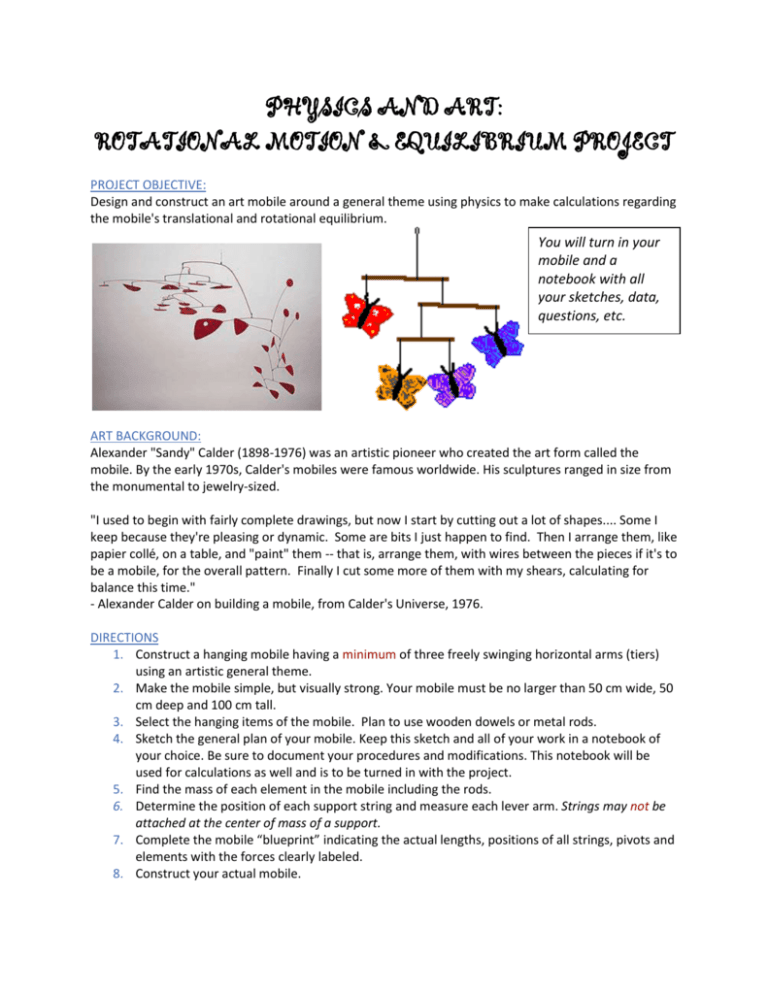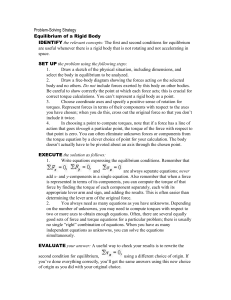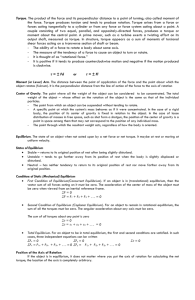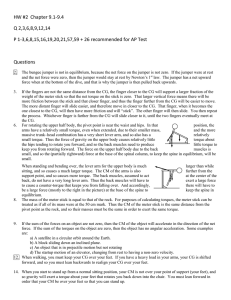physics and art: rotational motion & equilibrium project
advertisement

PHYSICS AND ART: ROTATIONAL MOTION & EQUILIBRIUM PROJECT PROJECT OBJECTIVE: Design and construct an art mobile around a general theme using physics to make calculations regarding the mobile's translational and rotational equilibrium. You will turn in your mobile and a notebook with all your sketches, data, questions, etc. ART BACKGROUND: Alexander "Sandy" Calder (1898-1976) was an artistic pioneer who created the art form called the mobile. By the early 1970s, Calder's mobiles were famous worldwide. His sculptures ranged in size from the monumental to jewelry-sized. "I used to begin with fairly complete drawings, but now I start by cutting out a lot of shapes.... Some I keep because they're pleasing or dynamic. Some are bits I just happen to find. Then I arrange them, like papier collé, on a table, and "paint" them -- that is, arrange them, with wires between the pieces if it's to be a mobile, for the overall pattern. Finally I cut some more of them with my shears, calculating for balance this time." - Alexander Calder on building a mobile, from Calder's Universe, 1976. DIRECTIONS 1. Construct a hanging mobile having a minimum of three freely swinging horizontal arms (tiers) using an artistic general theme. 2. Make the mobile simple, but visually strong. Your mobile must be no larger than 50 cm wide, 50 cm deep and 100 cm tall. 3. Select the hanging items of the mobile. Plan to use wooden dowels or metal rods. 4. Sketch the general plan of your mobile. Keep this sketch and all of your work in a notebook of your choice. Be sure to document your procedures and modifications. This notebook will be used for calculations as well and is to be turned in with the project. 5. Find the mass of each element in the mobile including the rods. 6. Determine the position of each support string and measure each lever arm. Strings may not be attached at the center of mass of a support. 7. Complete the mobile “blueprint” indicating the actual lengths, positions of all strings, pivots and elements with the forces clearly labeled. 8. Construct your actual mobile. HINTS 1. You are likely to achieve the best results by starting with the lowest level and working upward. 2. Use objects of moderate mass. Do not use fragile or expensive objects. Handmade objects are acceptable. 3. Be creative. Use a theme you like! 4. Plan ahead! Calculate carefully and accurately. CALCULATIONS – Part 1 Answer the following questions in your notebook. Refer to the following information for the next five questions. Two ropes, having tensions T2 and T3, support a uniform 100-N beam and two weights. If the right weight has a mass of 25 kg and T2 has a tension of 500 N, calculate the tension in T3 as well as the mass of the unknown weight. 1. 2. 3. 4. 5. What equation places the system in vertical equilibrium? What equation places the system in horizontal equilibrium? What equation places the system in rotational equilibrium? What is the value of T3? What is the mass of the suspended block? For the seesaw to be in rotational equilibrium, the torques acting on it must be balanced. That is, the clockwise torque created by the 500 N boy sitting on the right end must equal the counterclockwise torque created by the boy hanging from the left end. The torque produced by a force is calculated as the product of its magnitude, strength in Newtons, times the perpendicular distance from its line of action to the pivot point, or its moment arm. 6. What is the weight of the boy hanging from the left end? 7. What is the boy’s mass? For the seesaw to be in rotational equilibrium, the torques acting on it must be balanced. That is, the clockwise torque created by the 400 N boy sitting on the right end must equal the counterclockwise torque created by the 300 N girl sitting on the left side. The torque produced by a force is calculated as the product of its magnitude, strength in Newtons, times the perpendicular distance from its line of action to the pivot point, or its moment arm. 8. How far away from the fulcrum is the boy on the right sitting? Refer to the following information for the next two questions. The broom balances at its center of gravity. 9. If you cut the broom into two pieces at the center of gravity and weigh each part of the broom, which end would weigh more? 10. Explain why each end has or does not have the same weight? (Hint: Compare this to one of the seesaw systems above.) Refer to the following information for the next eight questions. In the following diagram, develop an expression for the mass of the fish and the tension in the rope based on the mass of the blue block, M1, and the mass of the purple block, M2. First we must set up the equations for static equilibrium. 11. The sum of the forces on the right must equal the sum of the forces on the left. Write an equation to express this statement. 12. The sum of the upward forces must equal the sum of the downward forces. Write an equation to express this statement. Now we will begin to develop the beam's equation for rotational equilibrium. 13. Using the point where the rope attaches to the rod as our pivot point, what are the lever arms for each of the forces? 14. Which forces will produce a clockwise torque? 15. Which forces produce a counter-clockwise torque? 16. Write expressions for each of the non-zero torques. 17. The sum of the torques must add up to zero. Write an equation to express this statement. 18. Solve your equation for torque for the weight of the fish. 19. What is the mass of the fish? 20. What is the tension in the supporting rope? CALCULATIONS – Part 2 Next you will demonstrate by neat calculations that translational and rotational equilibrium exists in your mobile. Use the blueprint of your mobile to answer the following questions. 1. Make a data table listing every mass and lever arm in your mobile. 2. Calculate the weight of every component in your mobile. 3. For each tier, write an equation that expresses how the sum of the forces on the right must equal the sum of the forces on the left. 4. Show mathematically how the horizontal forces of your mobile are in equilibrium. 5. For each tier, write an equation that expresses how the sum of the upward forces must equal the sum of the downward forces. 6. Show mathematically how the vertical forces of your mobile are in equilibrium. 7. List the forces in your mobile that produce a clockwise torque. 8. List the forces in your mobile that produce a counterclockwise torque. 9. For each tier, write an equation that expresses how the clockwise and counterclockwise torques are in equilibrium. 10. Show mathematically how your mobile is in rotational equilibrium.







